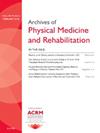Unpacking the Complexity of Implementing Robotic Technology for Multiple Disciplines: A Mixed Methods Study 4355
IF 3.6
2区 医学
Q1 REHABILITATION
Archives of physical medicine and rehabilitation
Pub Date : 2025-04-01
DOI:10.1016/j.apmr.2025.01.040
引用次数: 0
Abstract
Objectives
To study the integration of robotic technologies across inpatient, outpatient and community rehabilitation services.
Design
Mixed methods over a 12-month period, using descriptive statistics to analyze device usage data and thematic analysis of semistructured clinician interviews.
Setting
A rehabilitation center in Australia.
Participants
Clinicians from physiotherapy, occupational therapy, recreational therapy, speech pathology and dietetics, and allied health assistants working in inpatient, outpatient and community services.
Interventions
Not applicable.
Main Outcome Measures
Device-specific usage and multidisciplinary experiences and perceptions of introducing robotic rehabilitation technologies.
Results
Device usage increased from 219 to 511 uses per month 11 months later, totaling 4262 uses across 25 different devices by 271 patients with a range of neurological conditions across the year. In about 20% of therapy sessions multiple devices were used. The 25 interviewed clinicians understood that the new technologies were additions to their clinical toolkit requiring them to think and practice differently, but they struggled with discipline-technology fit and were overwhelmed by the volume of training required for each device. Early on, clinicians from disciplines that typically target impairments found it easier to integrate technology than disciplines with a dominant participation focus, but this changed over time as evidenced in increasing diversity of session goals and the clinicians’ stories. Although technology was found to enhance patient engagement, it also required many clinicians to upskill to effectively navigate patients’ high expectations of robotic technologies. Key factors in successful implementation were clinician buy-in, a well-designed staff training model, real time on the ground support, and responsiveness to differences between inpatient, outpatient and community services.
Conclusions
Ultimately, clinicians came to embrace technology's role in rehabilitation but emphasized its use alongside traditional therapy methods, guided by strong clinical reasoning and clear goals. This study adds value by using implementation science and including multiple perspectives.
Disclosures
none.
多学科机器人技术实现的复杂性:一种混合方法研究[j]
目的研究机器人技术在住院、门诊和社区康复服务中的整合。designmix方法在12个月的时间内,使用描述性统计分析设备使用数据和半结构化临床医生访谈的主题分析。澳大利亚的一个康复中心。参与者来自物理治疗、职业治疗、娱乐治疗、语言病理学和营养学的临床医生,以及在住院、门诊和社区服务部门工作的联合健康助理。InterventionsNot适用。主要结果测量设备特定的使用和多学科的经验和引入机器人康复技术的看法。结果11个月后,设备使用率从每月219次增加到每月511次,271名患有一系列神经系统疾病的患者全年使用25种不同设备共计4262次。在大约20%的治疗过程中使用了多种设备。接受采访的25位临床医生明白,新技术是他们临床工具包的补充,要求他们以不同的方式思考和实践,但他们在学科与技术的契合方面遇到了困难,并且被每台设备所需的大量培训所淹没。早期,通常针对损伤的学科的临床医生发现,与主要关注参与的学科相比,整合技术更容易,但随着时间的推移,这种情况发生了变化,这在会议目标和临床医生故事的多样性中得到了证明。尽管人们发现技术可以提高患者的参与度,但它也要求许多临床医生提高技能,以有效地满足患者对机器人技术的高期望。成功实施的关键因素是临床医生的支持、设计良好的员工培训模式、实时的实地支持以及对住院、门诊和社区服务之间差异的响应能力。最终,临床医生开始接受技术在康复中的作用,但在强有力的临床推理和明确的目标指导下,强调其与传统治疗方法一起使用。本研究通过运用实施科学和包括多种观点来增加价值。
本文章由计算机程序翻译,如有差异,请以英文原文为准。
求助全文
约1分钟内获得全文
求助全文
来源期刊
CiteScore
6.20
自引率
4.70%
发文量
495
审稿时长
38 days
期刊介绍:
The Archives of Physical Medicine and Rehabilitation publishes original, peer-reviewed research and clinical reports on important trends and developments in physical medicine and rehabilitation and related fields. This international journal brings researchers and clinicians authoritative information on the therapeutic utilization of physical, behavioral and pharmaceutical agents in providing comprehensive care for individuals with chronic illness and disabilities.
Archives began publication in 1920, publishes monthly, and is the official journal of the American Congress of Rehabilitation Medicine. Its papers are cited more often than any other rehabilitation journal.

 求助内容:
求助内容: 应助结果提醒方式:
应助结果提醒方式:


